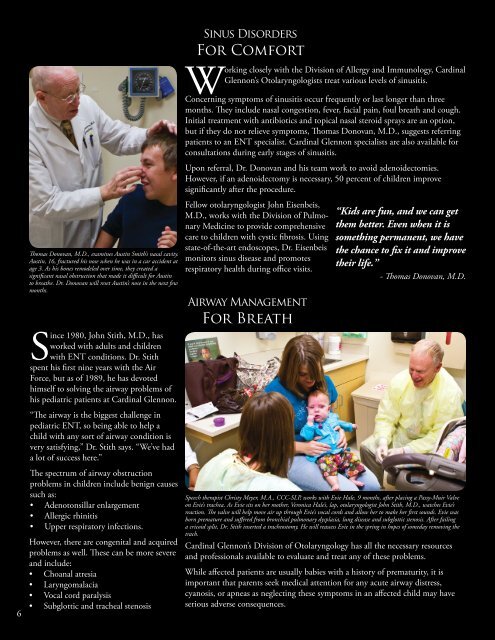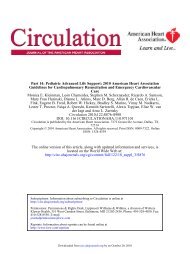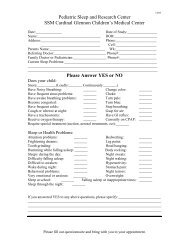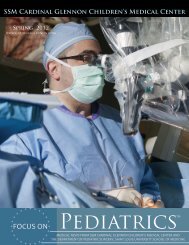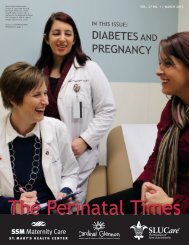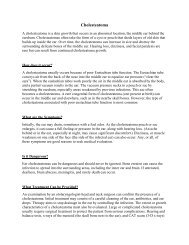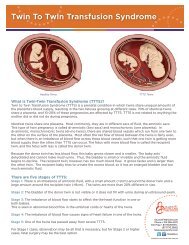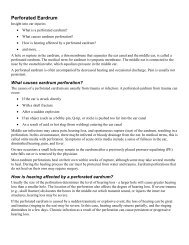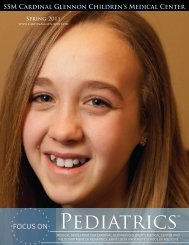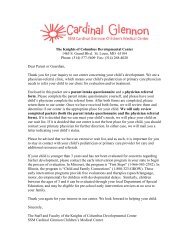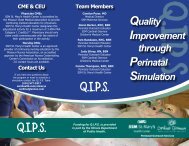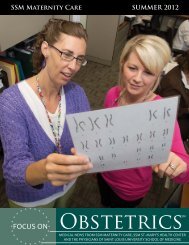Winter 2009/2010 - SSM Cardinal Glennon Children's Medical Center
Winter 2009/2010 - SSM Cardinal Glennon Children's Medical Center
Winter 2009/2010 - SSM Cardinal Glennon Children's Medical Center
Create successful ePaper yourself
Turn your PDF publications into a flip-book with our unique Google optimized e-Paper software.
Sinus DisordersFor ComfortWorking closely with the Division of Allergy and Immunology, <strong>Cardinal</strong><strong>Glennon</strong>’s Otolaryngologists treat various levels of sinusitis.Concerning symptoms of sinusitis occur frequently or last longer than threemonths. They include nasal congestion, fever, facial pain, foul breath and cough.Initial treatment with antibiotics and topical nasal steroid sprays are an option,but if they do not relieve symptoms, Thomas Donovan, M.D., suggests referringpatients to an ENT specialist. <strong>Cardinal</strong> <strong>Glennon</strong> specialists are also available forconsultations during early stages of sinusitis.Upon referral, Dr. Donovan and his team work to avoid adenoidectomies.However, if an adenoidectomy is necessary, 50 percent of children improvesignificantly after the procedure.Thomas Donovan, M.D., examines Austin Smith’s nasal cavity.Austin, 16, fractured his nose when he was in a car accident atage 3. As his bones remodeled over time, they created asignificant nasal obstruction that made it difficult for Austinto breathe. Dr. Donovan will reset Austin’s nose in the next fewmonths.Since 1980, John Stith, M.D., hasworked with adults and childrenwith ENT conditions. Dr. Stithspent his first nine years with the AirForce, but as of 1989, he has devotedhimself to solving the airway problems ofhis pediatric patients at <strong>Cardinal</strong> <strong>Glennon</strong>.“The airway is the biggest challenge inpediatric ENT, so being able to help achild with any sort of airway condition isvery satisfying,” Dr. Stith says. “We’ve hada lot of success here.”Fellow otolaryngologist John Eisenbeis,M.D., works with the Division of PulmonaryMedicine to provide comprehensivecare to children with cystic fibrosis. Usingstate-of-the-art endoscopes, Dr. Eisenbeismonitors sinus disease and promotesrespiratory health during office visits.Airway ManagementFor Breath“Kids are fun, and we can getthem better. Even when it issomething permanent, we havethe chance to fix it and improvetheir life.”- Thomas Donovan, M.D.6The spectrum of airway obstructionproblems in children include benign causessuch as:• Adenotonsillar enlargement• Allergic rhinitis• Upper respiratory infections.However, there are congenital and acquiredproblems as well. These can be more severeand include:• Choanal atresia• Laryngomalacia• Vocal cord paralysis• Subglottic and tracheal stenosisSpeech therapist Christy Meyer, M.A., CCC-SLP, works with Evie Hale, 9 months, after placing a Passy-Muir Valveon Evie’s trachea. As Evie sits on her mother, Veronica Hale’s, lap, otolaryngologist John Stith, M.D., watches Evie’sreaction. The valve will help move air up through Evie’s vocal cords and allow her to make her first sounds. Evie wasborn premature and suffered from bronchial pulmonary dysplasia, lung disease and subglottic stenosis. After failinga cricoid split, Dr. Stith inserted a tracheostomy. He will reassess Evie in the spring in hopes of someday removing thetrach.<strong>Cardinal</strong> <strong>Glennon</strong>’s Division of Otolaryngology has all the necessary resourcesand professionals available to evaluate and treat any of these problems.While affected patients are usually babies with a history of prematurity, it isimportant that parents seek medical attention for any acute airway distress,cyanosis, or apneas as neglecting these symptoms in an affected child may haveserious adverse consequences.


